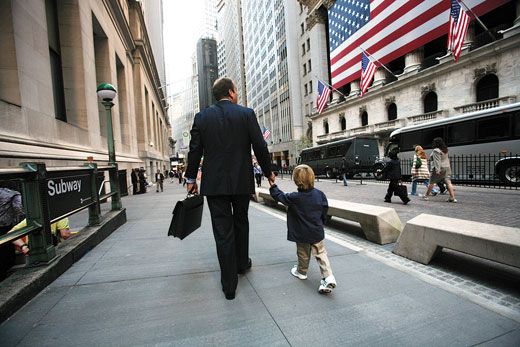Who Would Live on Wall Street?
In the wake of the financial crisis, New York’s financial district is getting something new: full-time residents
At the end of 2011, the Occupy Wall Street protesters took down their tents and dispersed. But another group of 60,000 occupiers remain behind. Most of these invaders have trickled quietly into Lower Manhattan over the past decade, taking over one office building after another. And they have no intention of ending their occupation. This is their home.
The transformation of the once-desolate financial district into a chic residential enclave would have amazed the most prescient urban planners of the 20th century. But the demographic shift from the suburbs to the inner cities will define the coming decades, says journalist Alan Ehrenhalt in his new book, The Great Inversion and the Future of the American City. The central areas of many cities “that were undesirable only ten years ago have become desirable,” Ehrenhalt says. Currently, some 29,000 people live in the Chicago Loop area, a 79 percent increase since 2000. The population of Philadelphia’s Center City is up nearly 27 percent since the 1990s.
The Wall Street influx was boosted in part by city tax breaks, which led to lower rents, and also, somewhat perversely, by the World Trade Center terrorist attacks, which drove many businesses from the south end of the island. Would-be dwellers snapped up the vacant office space as soon as it was retrofitted into housing.
Elsewhere the migration is being fueled by rising commute times, falling street crime and, most importantly, a shift in cultural values.
“So much of [young people’s] communication is virtual,” Ehrenhalt says. “ They want physical contact. We haven’t lost our desire for physical sociality,” which can be hard to come by behind a white picket fence.
As the well-to-do nest in the inner cities, suburbia is changing as well. Ehrenhalt says outer-ring suburbs are now becoming the province of immigrants. While it used to take immigrant families generations to leave urban centers, many are now being priced out before they arrive: In the Atlanta area today, just 4 percent of new immigrants settle in the city.
Perhaps nothing exemplifies the “trading places” migration better than suburbia’s oversize symbols of success, the McMansions. Ehrenhalt expects that as wealthy people occupy the inner cities, many of these increasingly vacant structures will be divided into condos—convenient starter homes for ambitious immigrants on the other side of the American dream.
